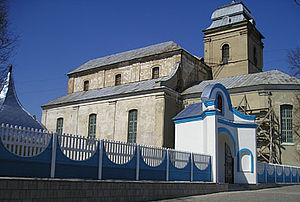Cathedral of St. Nicholas (former church and monastery of bernardine of the XVIIth century)
The church and monastery of bernardine were founded by the owner of the city, prince Janusz of Ostroh in 1614. Construction was completed by princes Olexandr and Vladyslav-Dominic of Zaslav. The location of the monastery on the western outskirts of the city complemented its defense capability. The mighty bell tower of the church served guard and defense functions.
A garden with fruit trees was in the eastern part of the monastery. In addition to the buildings within the estate, the monastery also owned houses behind the fence. A wooden house was to the north that served as a brewery. On the south side leading to the city center, a hospital building for the elderly belonged to the church. In the second half of the ХVІІІth century several rococo altars were built in the church. The disciples of the famous carving master – Lviv sculptor John Pinzel, who is called the Ukrainian Michelangelo, took part in the creation of these altars.
Burials of noble families Sanhushko, Liubomyr, Illinsk, Frankovsk were in the dungeons of this cathedral. The underground passage leading from the defensive moat to the dungeons of the church was described by M. Hohol in the world-famous story Taras Bulba.
In 1855, the church was consecrated to the Orthodox cathedral of St. Nicholas. In 1909, the cathedral of St. Nicholas was relocated to the newly built church of St. Elias, and in the buildings of bernardine opened a women’s Orthodox monastery.
With the arrival of the Polish authorities in 1921, bernardines returned here, and in 1928 they left the monastery. At the same time, a seminary of the Byzantine-Slavic rite was founded in the buildings of the monastery.
After the Second World War, the monastery housed a haberdashery factory and changed the appearance of the monastery beyond recognition. The monastery has a warehouse. Since 1993, there is cathedral of St. Nicholas.

